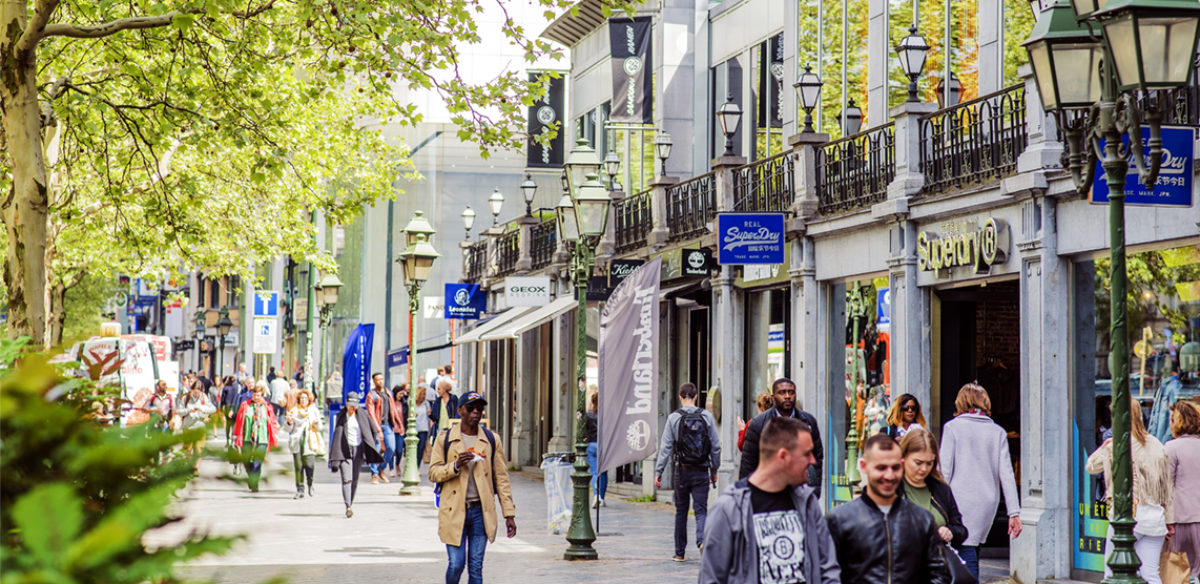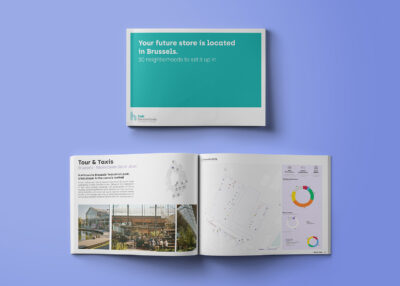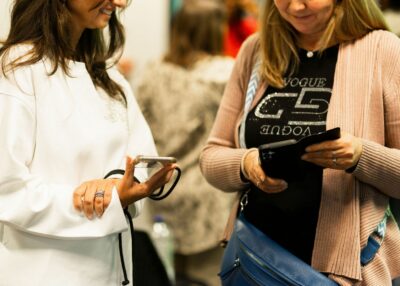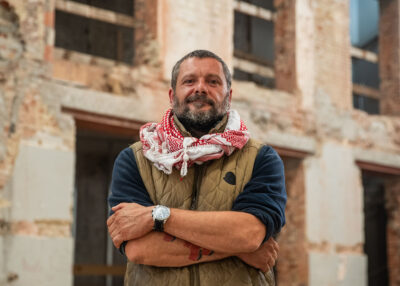
Purchasing behaviour of Brussels’ residents
As part of the Business Development Plan for the Brussels-Capital region, hub.brussels has carried out a series of analyses in partnership with Perspective.brussels and the Free University of Brussels. It has used the results of these analyses to contextualise the current situation of, and changes to, retail provision. This article looks at the spatial consumption habits of Brussels’ households: it offers an analysis of the places frequented by the region’s residents according to their place of residence and the type of products they purchase.
The work conducted by our Agency and our two partners is so unprecedented that no such study has been carried out in Brussels since the start of the 1990s, and never at this level of geographical precision, namely the residential areas.
The study therefore looks only at the population of Brussels, something which can limit the appraisal of the performance of certain shops since neither clients from the rest of Belgium, nor tourists are taken into account. Here are the main conclusions.
5.5 billion euros spent on retail trade
The Brussels-Capital Region has more than 542,000 households. Estimations confirm that these households spent approximately 5.5 billion euros spent on retail trade every year.
More than half (three billion euros) is dedicated to everyday consumer goods (food and household products and medication). The rest is spread between two other spending categories, up to 1.5 billion euros each year on semi-durable light goods (clothes, books, films, sports equipment, etc.) and up to one billion euros per year for semi-durable heavy goods (DIY materials, electrical appliances, furniture, etc.).
A Brussels household’s average yearly spend on retail goods is estimated to be 9,200 euros. It is noted that the share of expenditure in these three purchase categories varies considerably according to the socio-economic profile of the household surveyed.
Local research focused on regular purchases
Households in Brussels favour nearby locations and making short journeys for their essential shopping, particularly because of the wide spatial coverage of the outlets dedicated to these purchases. For regular purchases, this results in the spending of Brussels’ residents being distributed across a large number of commercial hubs and also in stand-alone shops (The scattered stand-alone provision accounts for more than 30% of Brussels expenditure, that is six times greaterthan for other purchases).
The supermarket remains the place of choice for the population of Brussels for everyday purchases, representing more than 95% of the locations given by the respondents for their large shopping trips. It’s worth noting that markets also have a significant place in the Brussels commercial landscape.
The purchase of semi-regular light goods focuses on a few destinations
When purchasing semi-regular light goods, the behaviour of Brussels residents is often linked to places offering a significant promotion. Therefore, logically we find the city centre at the top of the destinations for this type of purchase, on its own attracting more than a quarter of the area’s spending.
The rest is concentrated in only a few locations, mainly the Haut de la Villeand the Woluwe Shopping Centre and Westland Shopping. Together, these four destinations account for more than 50% of annual household spending in Brussels.
In this category of purchases, e-commerce also has a significant place in spending in Brussels, reaching 6% of the market share.
Purchasing power avoidance for semi-regular heavy purchases
Within the region, spending dedicated to semi-regular heavy purchases is concentrated in a few places, bringing together major retailers whose distribution is more widely spread and more balanced than for the previous category. The main purchasing destination is the retail park that houses the only Ikea in the region and accounts for more than 10% of Brussels spending. The other places most visited by the residents of Brussels are Bruxelles-Centre, the Basilix Shopping Center, the Woluwe Shopping Center and the Auderghem shopping area.
On the other hand, for this category of purchases, more than 25% of the yearly spending takes place outside of Brussels and is concentrated on a few retail parks at the edge of the region (Zaventem, Drogenbos and even Sint-Pieters-Leeuw).
13.1% of yearly spending happens outside of Brussels
In addition to purchasing behaviour in the region, this study also looked at the avoidance of purchasing power. With all purchase categories combined, 13.1% of Brussels households’ yearly spending occurs outside of the region. Of this amount, more than a half is allocated to shops located in Brabant Flamand and is spent in areas predominantly hosting chains (Ikea Zaventem, the Drogenbos shopping centre, etc.).
This avoidance mainly affects the suburbs closest to the regional border, which proves that the proximity effect has a lot to do with purchasing behaviours. The large majority of the purchases made by Brussels households outside of Brussels are made within 15 km of the centre. Proof that the Brussels commercial framework is not limited to regional borders and that consideration of commercial development should take the outskirts into account.
After the outskirts of Brussels, the avoidance of purchasing power mainly benefits retailers without physical premises. Amongst them, the most significant point of expenditure is online purchases, which have a combined market share of 2.2%. It is noted that against all expectations, online purchases are made by all age groups.
A multi-centred commercial space
Generally speaking, the survey has shown that chain stores (brands) dominate Brussels residents’ perception of the commercial landscape and strongly impact the spatial behaviours of households. Thus, we observe the good performance of the recently built retail parks in the second-ring suburbs (Woluwe Shopping Center, Auderghem Shopping, Basilix Shopping Centre, etc.) and those in the outskirts, and also some traditional major areas (Brussels city centre and the Haut de la Ville, or even Miroir, the centre of Uccle, La Bascule, etc.), show that the Brussels-Capital Region, despite its attractive centre, is a multi-centredcommercial space that is not limited to its administrative borders.
Let’s not forget that the majority of expenditure is for regular purchases, for which households in Brussels prefer nearby places and smaller-scale retailers, often located outside the commercial hub. There are many shops that receive the majority of their income from regular purchases, proof that local food retailers are an essential element in maintaining retail spaces and, more specifically, traditional shopping districts.
Finally, it is noteworthy that, by analysing retail spaces in terms of yield to take their size into account, certain small hubs have shown very good scores (Sainte-Alix, Altitude 100, Place Keym, etc.), proof that it is not necessarily necessary to reach a significant size to guarantee the vitality of a commercial space. This element is reinforced by the success of some isolated sales outlets, which are proving themselves to be amongst the most visited by Brussels residents (e.g. Caméléon and Filigranes).
55% of Brussels residents use the car to make their purchases
This study is also interested in purchasing behaviours from the point of view of mobility. This made it possible to note that the car remains the major mode of transport used by Brussels residents for their shopping, before public transport and walking. More than 55% of respondents state that the car is their main method of transport, however, we note a variation in this percentage according to the level of income, the age group and the residential area of the households surveyed.
The survey has also, quite logically, made it possible to note longer journeys for semi-regular purchases (on average 3.6 km per household) compared to regular purchases (2.2 km). Distances become even greater as the residential area becomes further away from the main shopping destinations.
In order to summarise these travel patterns, the study divided the region into consumption pools, areas in which there is a strong relationship between the range of shops and the residential population.
The latter of these reflects the distribution of provision in the region and confirms the way in which Brussels is structured around several commercial polarities, which are mostly arranged around a single place.
Blog

Brussels to California: keeping the American Dream alive
Posted on 27/10/2025
Retail Barometer 2025: what Brussels’ commercial dynamics are telling us
Posted on 27/10/2025
5 free programmes to test your business idea
Posted on 05/09/2025
hub.info: 15 years of guidance for Brussels entrepreneurs
Posted on 05/09/2025
Women Digital Festival : boost your digital skills
Posted on 03/09/2025Thanks to the sponsors of Schéma de Développement commercial:

